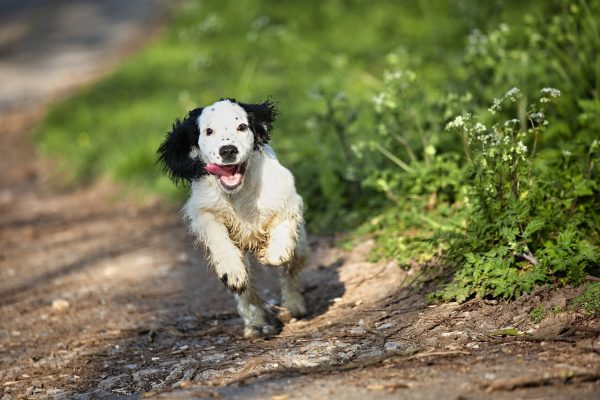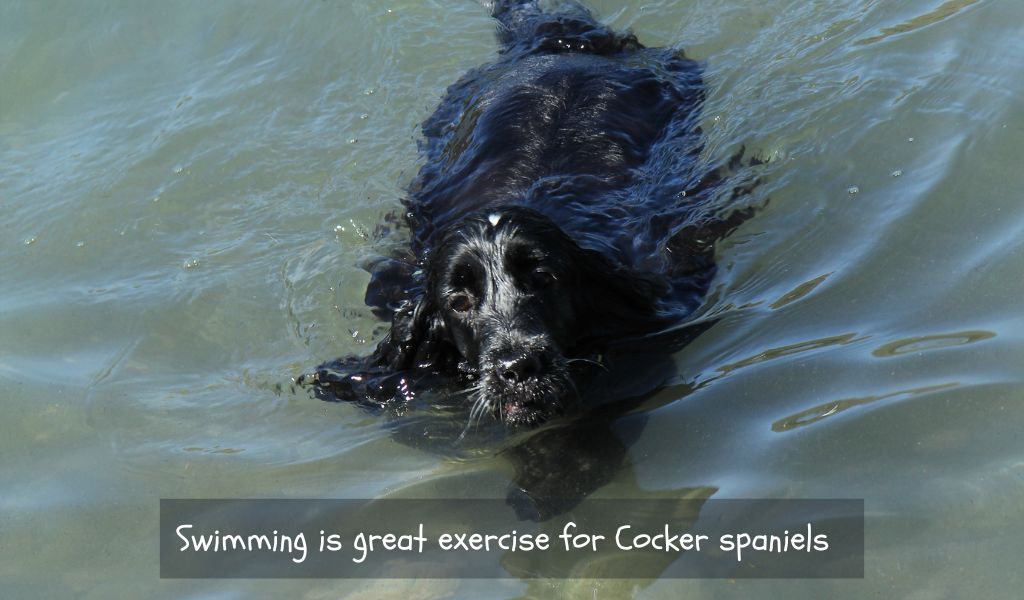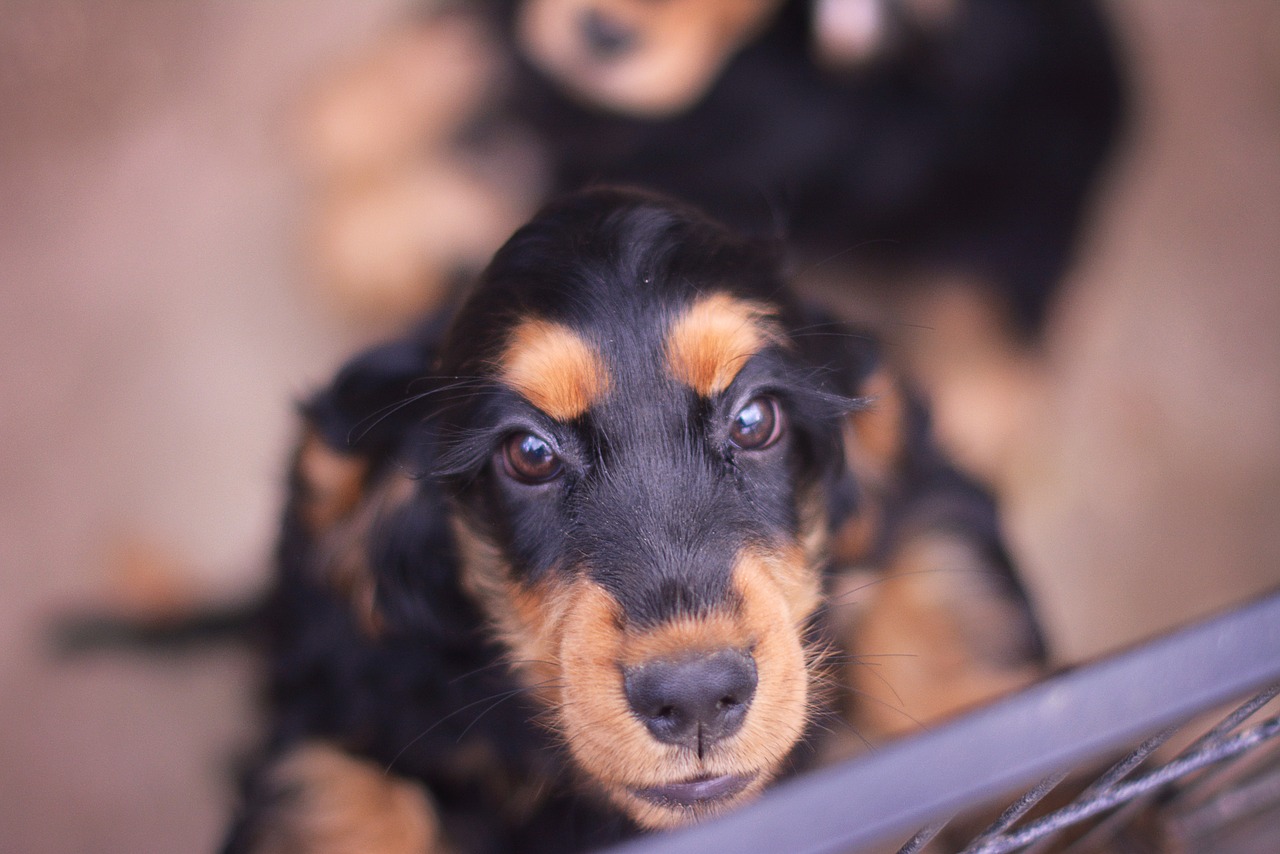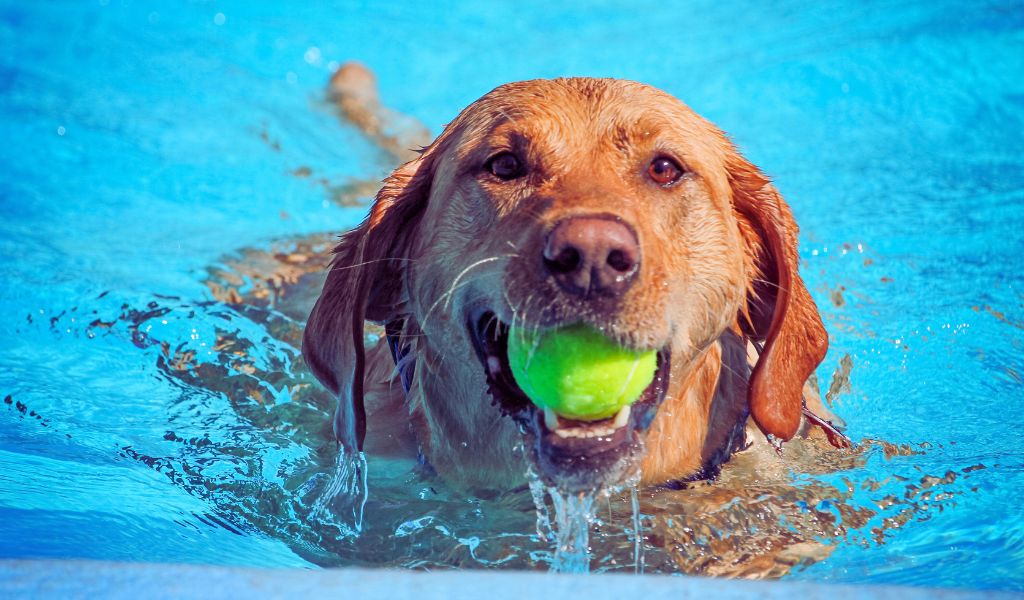Cocker spaniels need at least an hour’s exercise daily, and, if possible more, it should consist of some free running to get the blood flowing and to burn off some calories and energy. Try to let your Cocker play in between walks to help him expend his energy and tire him out.
Cocker spaniels love going for walks and need good amounts of exercise every day in order to keep them in the best of health.
I’m fortunate where I live as within a few minutes we are into open fells where my two Cockers can run freely whenever we are not training.
How long should a Cocker spaniel be walked for?
Ideally you should look to try and get your Cocker out two or three times daily, at a minimum.
Cockers, like most of the spaniel breeds, are high energy dogs that need good levels of exercise.
A Cocker spaniel puppy will need regular, short walks, as he will get tired easily, and too much vigorous exercise at a young age, could lead to injury.
If you have a yard or garden then a puppy will enjoy scampering around. This is also a good opportunity to introduce puppy toilet training.
Adult Cocker spaniels are much tougher than puppies and they will enjoy good, demanding exercise.
If you can find places where they can run free, without fear of disturbing livestock, then letting them charge around, chasing their noses, is ideal exercise for them.
Cocker spaniel walking time by age
| Age (Months) | Recommended Walking Time (Minutes) |
| 3 | 10 – 15 |
| 6 | 20 – 30 |
| 9 | 30 – 45 |
| 12 | 45 – 60 |
| 15 | 45 – 60 |
| 18 | 50 – 70 |
Is one walk a day enough for a Cocker spaniel?
This will depend on how far you walk with your dog and the type of exercise. Generally speaking the longer the individual walk, the less the number of walks needed.
All dogs are different and older dogs are more likely to be content with one walk than younger, more active individuals.
You also need to factor in the time of year, weather and your fitness levels and time available.
A Cocker will never get bored of going for a walk so, if you can provide him with more than one walk a day, he will enjoy the opportunity to run around and enjoy himself.

Cockers love going out
Cocker spaniels love going for walks and adventures
A good, long daily walk of at least an hour will keep your Cocker entertained
Always let a spaniel have free running exercise off the lead
Older dogs normally need less exercise than youngsters – although in the case of Cockers, as many owners will testify, this is often not the case.
Exercising a working Cocker spaniel
If your Cocker is a working dog, or trained for other purposes, then you will need to keep a close eye on him when he is out ‘exercising’.
Free running is a great way to keep your Cocker fit and strong and, particularly during the summer months, when there is no work for him, running free is ideal – as is any form of cardiovascular exercise.
However, you must keep an eye on your dog and monitor his free running.
As a working dog his instinct will be to hunt and, if you allow too much free hunting, then he is likely to begin to ignore you and cast himself too far away from you.
Keep him close, use the whistle or call his name.
An option that I use for Boris and Nimrod when we go out, is to let them do their ‘business first, with a sniff around, call them in and then set them off hunting, as though we are out shooting.
After a few minutes, I’ll get them into heel, maybe put their leads on for a while, and then, when we are heading back to the car, I’ll allow then to run and ‘play’ – while watching them closely.
Your Cocker needs to run free, you can’t keep him on a lead for the whole walk, just watch him when he is and you’ll help to avoid any bad habits from creeping in.
How far can a Cocker spaniel walk?
Further than I can, would be the easy answer. Seriously though, they can walk a serious distance.
Although I have successfully tired a spaniel out before, it was not easy and most spaniels have the to go on and on and on.
Today, for example, my two Cockers were out first thing this morning on the fell.
We did some training for about twenty minutes, followed by a walk while they ran through the heather and rushes.
After getting home they spent most of the morning and early afternoon helping me do some outdoor jobs, their support was in the form of digging holes everywhere.
They have just gone out again with my daughter, to climb the steepest fell in the area, a walk of around 2 to 3 miles.
I suspect that when they get back, they’ll eat, sleep for about 30 minutes and then they will be back to ‘full power’, ready for more.

How far can a Cocker spaniel run?
Before I had knee surgery I used to run a lot. I would often take one of the dogs with me.
If I ran 5 miles across the fell, then the dog would probably run double that, as he ran back and forwards.
If you are planning to go running with your Cocker then try and go somewhere where your dog does not need to be on a lead, trust me, running with a spaniel that is on a lead, is like having a fish on a line, he’ll trip you up, you’ll get tangled up.
Best to run without the lead.
Also, try to run on a soft surface for the benefit of your dog. Roads and pavements can be damaging to his paws and his joints.
If possible run on grass or ‘off road’, if you can get to the beach then these are great places to go running with a dog.
The surface is soft, he can run free and you can easily see where he is, and, there’s normally water, so he can go for a dip too to cool off.
Is swimming good exercise for Cocker spaniels?
It certainly is. Swimming is a great way to help keep your spaniel fit and, from my experience, is one way to tire him out.
If you are lucky enough to live near a clean river or the sea, where is is safe to take your dog, then, swimming can be a great way to help him to burn off that excess energy that spaniels have.
You should always make sure that the water is safe for your dog and that it is not too fast flowing or, if a river, that it is not swollen and there is no risk of your dog being swept away.
Cocker spaniels do get cold so, swimming in cold weather is not ideal.
Clearly if your dog is working then there may be occasions when he does need to swim in the cold, but, for general exercise, swimming is best kept for warmer days.

How should I exercise an injured Cocker spaniel?
If your Cocker is recovering from an injury or surgery or other ailment, then you’ll need to change his exercise regime to help him with his recovery.
You should always listen to your vet and, if you have any doubts or need professional advice, then your vet is qualified and is the best person to help you.
Apart from reducing the time spent on walks and restricting free running there is little to do other than to be careful and aware of your dog’s condition and needs.
There are some places that provide recuperation services for dogs, such as hydrotherapy pools, which are heated and allow the dog to swim gently to aid recovery.
Your vet will be able to advise on these and any other specific exercise needs for your Cocker spaniel.
Introduce mental stimulation into your Cocker spaniel’s exercise
If you can make your spaniel’s exercise into something similar to a ‘doggy mission’ then this will help him to become tired.
Any form of mental stimulation is great for your Cocker spaniel, such as training, playing, chasing etc.
Simply playing ‘fetch’ with a tennis ball when out walking, will introduce some purpose into your dog’s walk and will stimulate his brain.
Throwing a ball and getting him to retrieve it encourages the chasing response whch most dogs love.
If you can make the game more interesting and difficult by making the ball harder to find so that he has to hunt for it, then that’s even better.
Try to exercise your spaniel’s brain as well as his body when you take him out.
How much exercise does a Cocker spaniel puppy need?

Puppies need less exercise than an adult dog. If you over exercise a puppy then you run the risk of causing damage to his bones and joints which could lead to arthritis.
General advice is to allow for 5 minutes of exercise per month of age , up to twice a day until the puppy is fully grown.
So, for example a four month old Cocker spaniel puppy would need 20 minutes of exercise twice a day.
As well as this exercise you will also need to take him out to use the toilet regularly.
How often should I walk an old Cocker spaniel?
It’s a fact that dogs, like people, get old and as they get old, they get slower and less active.
That doesn’t mean that you cannot enjoy walks with your Cocker spaniel, it just means that the walks may not be as long and he will probably get tired sooner.
It is important that your older Cocker gets out for regular walks, the exercise is good for him ( and for you) and you should try to maintain a routine with him as much as possible.
Try to take him out in the morning, when he has woken from a good night’s sleep.
He’ll probably have more energy at this time and he will enjoy the exercise.
How far you walk with him depends on your dog and you should watch him while you are out to see if he is getting tired.
He’ll probably sleep when he gets home.
Elderly spaniels sleep much more than younger dogs. Later in the day you could take him out again.
It all depends on your dog and if he has been with you for a while then you should know him pretty well and know what he enjoys.
FAQs
How often should I walk my Cocker Spaniel?
Cocker Spaniels are active and energetic dogs, so they require regular exercise to stay healthy and happy.
Ideally, they should be walked at least once a day, for a minimum of 30 minutes to an hour.
However, keep in mind that the specific exercise needs of your Cocker Spaniel may vary based on factors such as age, health, and individual temperament. Consulting with your veterinarian can help determine the appropriate exercise routine for your furry friend.
Can I meet my Cocker Spaniel’s exercise needs without daily walks?
While daily walks are highly recommended for Cocker Spaniels, it’s possible to meet their exercise needs through alternative activities as well.
These dogs enjoy playing fetch, participating in agility training, and engaging in interactive play sessions with their owners.
Mental stimulation, such as puzzle toys or obedience training, can also help tire them out.
However, it’s important to note that regular walks offer additional benefits like socialisation, exposure to different environments, and opportunities for them to explore and fulfill their natural instincts.
Are there any specific considerations for walking Cocker Spaniels?
When walking your Cocker Spaniel, there are a few things to keep in mind. Firstly, ensure they are properly controlled during walks to prevent them from running off or getting into potentially dangerous situations.
Secondly, pay attention to the weather conditions, as extreme heat or cold can impact their well-being. During hot weather, it’s important to avoid walking during the hottest parts of the day and provide plenty of water breaks.
Lastly, be mindful of their sensitive ears and keep them clean and dry, as Cocker Spaniels are prone to ear infections. Regular grooming and checking their ears after walks can help prevent any issues.
When we think about how often do Cocker spaniels need to be walked, we can see that it depends on the age and health of your dog.
Puppies and elderly Cockers will need less frequent exercise than healthy adult dogs.
Cockers that are recovering from injury or illnesses will need careful exercise as defined by your vet.




